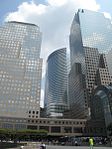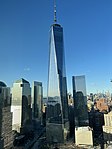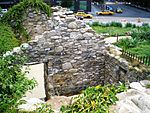200 West Street

200 West Street is the global headquarters of the Goldman Sachs investment banking firm in the Battery Park City neighborhood of Manhattan in New York City. The building is a 749-foot-tall (228 m), 44-story building located on West Street, between Vesey and Murray Streets in Lower Manhattan. It is adjacent to Brookfield Place and the Conrad Hotel, the Verizon Building, and the World Trade Center. It is the only office building in Battery Park City north of Brookfield Place. The skyscraper was designed by Henry N. Cobb of Pei Cobb Freed & Partners, with Adamson Associates Architects. Construction commenced in 2005 after New York City and state government officials gave Goldman Sachs large subsidies to fund the project. There were several incidents during construction, including a falling load that paralyzed an architect as well as a falling pane of glass. Workers started moving into 200 West Street in late 2009 and the project was completed the next year at a cost of $2.1 billion. The building received a Leadership in Energy and Environmental Design (LEED) gold certification.
Excerpt from the Wikipedia article 200 West Street (License: CC BY-SA 3.0, Authors, Images).200 West Street
West Street, New York Manhattan
Geographical coordinates (GPS) Address External links Nearby Places Show on map
Geographical coordinates (GPS)
| Latitude | Longitude |
|---|---|
| N 40.714722222222 ° | E -74.014444444444 ° |
Address
Goldman Sachs Tower (200 West Street)
West Street 200
10282 New York, Manhattan
New York, United States
Open on Google Maps








